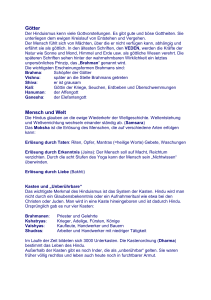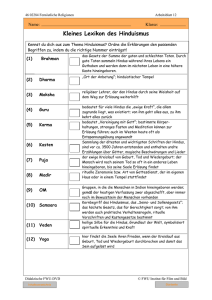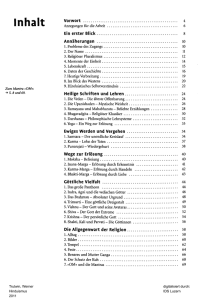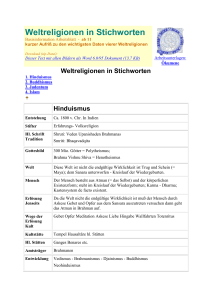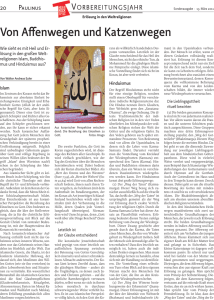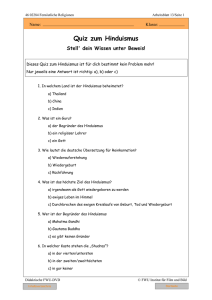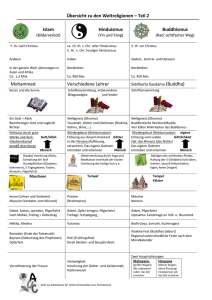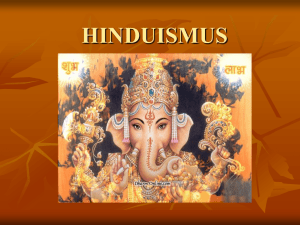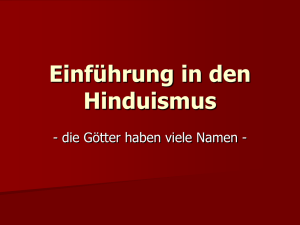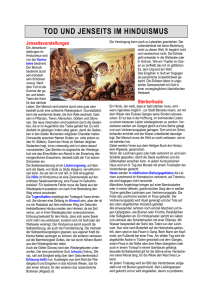2 - Oldenbourg
Werbung
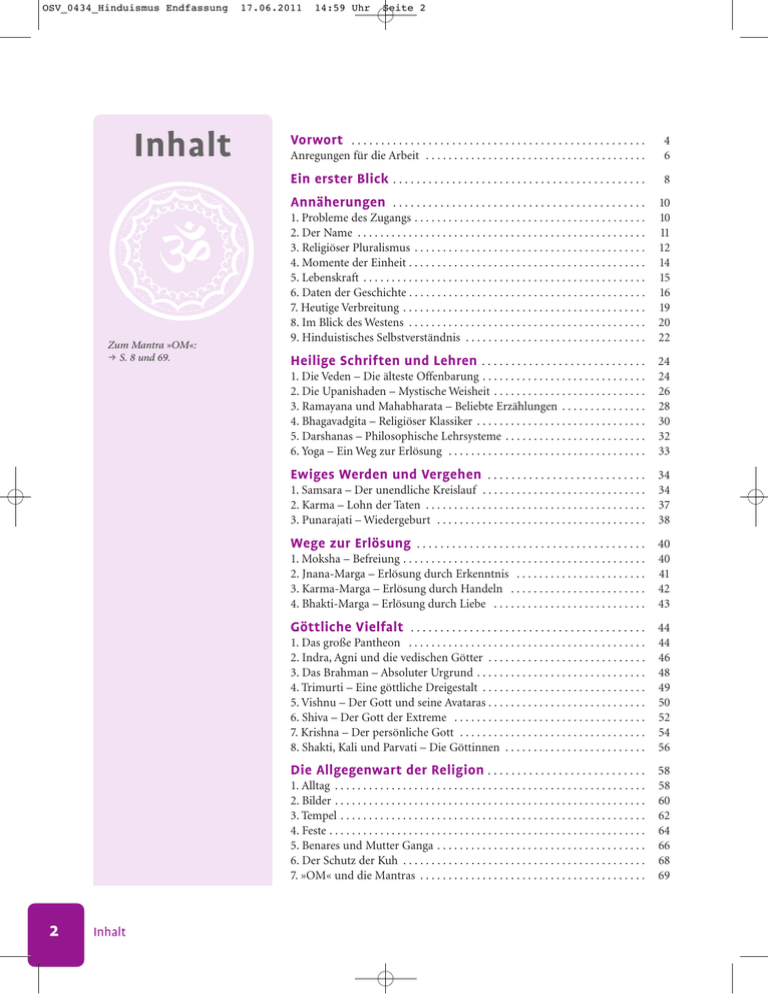
OSV_0434_Hinduismus Endfassung Inhalt 17.06.2011 14:59 Uhr Seite 2 Vorwort . . . . . . . . . . . . . . . . . . . . . . . . . . . . . . . . . . . . . . . . . . . . . . . . . . Anregungen für die Arbeit . . . . . . . . . . . . . . . . . . . . . . . . . . . . . . . . . . . . . . . 4 6 Ein erster Blick . . . . . . . . . . . . . . . . . . . . . . . . . . . . . . . . . . . . . . . . . . . 8 Annäherungen . . . . . . . . . . . . . . . . . . . . . . . . . . . . . . . . . . . . . . . . . . . 10 Zum Mantra »OM«: R S. 8 und 69. 1. Probleme des Zugangs . . . . . . . . . . . . . . . . . . . . . . . . . . . . . . . . . . . . . . . . . 2. Der Name . . . . . . . . . . . . . . . . . . . . . . . . . . . . . . . . . . . . . . . . . . . . . . . . . . . 3. Religiöser Pluralismus . . . . . . . . . . . . . . . . . . . . . . . . . . . . . . . . . . . . . . . . . 4. Momente der Einheit . . . . . . . . . . . . . . . . . . . . . . . . . . . . . . . . . . . . . . . . . . 5. Lebenskraft . . . . . . . . . . . . . . . . . . . . . . . . . . . . . . . . . . . . . . . . . . . . . . . . . . 6. Daten der Geschichte . . . . . . . . . . . . . . . . . . . . . . . . . . . . . . . . . . . . . . . . . . 7. Heutige Verbreitung . . . . . . . . . . . . . . . . . . . . . . . . . . . . . . . . . . . . . . . . . . . 8. Im Blick des Westens . . . . . . . . . . . . . . . . . . . . . . . . . . . . . . . . . . . . . . . . . . 9. Hinduistisches Selbstverständnis . . . . . . . . . . . . . . . . . . . . . . . . . . . . . . . . 10 11 12 14 15 16 19 20 22 Heilige Schriften und Lehren . . . . . . . . . . . . . . . . . . . . . . . . . . . . 24 1. Die Veden – Die älteste Offenbarung . . . . . . . . . . . . . . . . . . . . . . . . . . . . . 2. Die Upanishaden – Mystische Weisheit . . . . . . . . . . . . . . . . . . . . . . . . . . . 3. Ramayana und Mahabharata – Beliebte Erzählungen . . . . . . . . . . . . . . . 4. Bhagavadgita – Religiöser Klassiker . . . . . . . . . . . . . . . . . . . . . . . . . . . . . . 5. Darshanas – Philosophische Lehrsysteme . . . . . . . . . . . . . . . . . . . . . . . . . 6. Yoga – Ein Weg zur Erlösung . . . . . . . . . . . . . . . . . . . . . . . . . . . . . . . . . . . 24 26 28 30 32 33 Ewiges Werden und Vergehen . . . . . . . . . . . . . . . . . . . . . . . . . . . 34 1. Samsara – Der unendliche Kreislauf . . . . . . . . . . . . . . . . . . . . . . . . . . . . . 2. Karma – Lohn der Taten . . . . . . . . . . . . . . . . . . . . . . . . . . . . . . . . . . . . . . . 3. Punarajati – Wiedergeburt . . . . . . . . . . . . . . . . . . . . . . . . . . . . . . . . . . . . . 34 37 38 Wege zur Erlösung . . . . . . . . . . . . . . . . . . . . . . . . . . . . . . . . . . . . . . . 40 1. Moksha – Befreiung . . . . . . . . . . . . . . . . . . . . . . . . . . . . . . . . . . . . . . . . . . . 2. Jnana-Marga – Erlösung durch Erkenntnis . . . . . . . . . . . . . . . . . . . . . . . 3. Karma-Marga – Erlösung durch Handeln . . . . . . . . . . . . . . . . . . . . . . . . 4. Bhakti-Marga – Erlösung durch Liebe . . . . . . . . . . . . . . . . . . . . . . . . . . . 40 41 42 43 Göttliche Vielfalt . . . . . . . . . . . . . . . . . . . . . . . . . . . . . . . . . . . . . . . . 44 1. Das große Pantheon . . . . . . . . . . . . . . . . . . . . . . . . . . . . . . . . . . . . . . . . . . 2. Indra, Agni und die vedischen Götter . . . . . . . . . . . . . . . . . . . . . . . . . . . . 3. Das Brahman – Absoluter Urgrund . . . . . . . . . . . . . . . . . . . . . . . . . . . . . . 4. Trimurti – Eine göttliche Dreigestalt . . . . . . . . . . . . . . . . . . . . . . . . . . . . . 5. Vishnu – Der Gott und seine Avataras . . . . . . . . . . . . . . . . . . . . . . . . . . . . 6. Shiva – Der Gott der Extreme . . . . . . . . . . . . . . . . . . . . . . . . . . . . . . . . . . 7. Krishna – Der persönliche Gott . . . . . . . . . . . . . . . . . . . . . . . . . . . . . . . . . 8. Shakti, Kali und Parvati – Die Göttinnen . . . . . . . . . . . . . . . . . . . . . . . . . 44 46 48 49 50 52 54 56 Die Allgegenwart der Religion . . . . . . . . . . . . . . . . . . . . . . . . . . . 58 1. Alltag . . . . . . . . . . . . . . . . . . . . . . . . . . . . . . . . . . . . . . . . . . . . . . . . . . . . . . . 2. Bilder . . . . . . . . . . . . . . . . . . . . . . . . . . . . . . . . . . . . . . . . . . . . . . . . . . . . . . . 3. Tempel . . . . . . . . . . . . . . . . . . . . . . . . . . . . . . . . . . . . . . . . . . . . . . . . . . . . . . 4. Feste . . . . . . . . . . . . . . . . . . . . . . . . . . . . . . . . . . . . . . . . . . . . . . . . . . . . . . . . 5. Benares und Mutter Ganga . . . . . . . . . . . . . . . . . . . . . . . . . . . . . . . . . . . . . 6. Der Schutz der Kuh . . . . . . . . . . . . . . . . . . . . . . . . . . . . . . . . . . . . . . . . . . . 7. »OM« und die Mantras . . . . . . . . . . . . . . . . . . . . . . . . . . . . . . . . . . . . . . . . 2 Inhalt 58 60 62 64 66 68 69 OSV_0434_Hinduismus Endfassung 07.07.2011 10:41 Uhr Seite 3 8. Der Guru . . . . . . . . . . . . . . . . . . . . . . . . . . . . . . . . . . . . . . . . . . . . . . . . . . . . 9. Götter, Geister und Gestirne . . . . . . . . . . . . . . . . . . . . . . . . . . . . . . . . . . . . 10. Tantra – Kontakt mit der göttlichen Welt . . . . . . . . . . . . . . . . . . . . . . . . 70 71 72 Die moralische Ordnung des Lebens . . . . . . . . . . . . . . . . . . . . 74 1. Dharma – Das oberste Gesetz . . . . . . . . . . . . . . . . . . . . . . . . . . . . . . . . . . . 2. Die vier Lebensstadien . . . . . . . . . . . . . . . . . . . . . . . . . . . . . . . . . . . . . . . . 3. Ethos der Laien und Asketen . . . . . . . . . . . . . . . . . . . . . . . . . . . . . . . . . . . 4. Ehe und Familie . . . . . . . . . . . . . . . . . . . . . . . . . . . . . . . . . . . . . . . . . . . . . . 5. Witwenverbrennung . . . . . . . . . . . . . . . . . . . . . . . . . . . . . . . . . . . . . . . . . . 6. Die neue Rolle der Frau . . . . . . . . . . . . . . . . . . . . . . . . . . . . . . . . . . . . . . . 7. Sarojini Naidu – Eine aktive Politikerin . . . . . . . . . . . . . . . . . . . . . . . . . . . 8. Worte indischer Weiser . . . . . . . . . . . . . . . . . . . . . . . . . . . . . . . . . . . . . . . . 74 76 77 78 81 82 84 85 Das Kastenwesen . . . . . . . . . . . . . . . . . . . . . . . . . . . . . . . . . . . . . . . . 86 1. Ein religiöses Gesellschaftssystem . . . . . . . . . . . . . . . . . . . . . . . . . . . . . . . 2. Der Dharma der Kasten . . . . . . . . . . . . . . . . . . . . . . . . . . . . . . . . . . . . . . . 3. Die Ursprünge . . . . . . . . . . . . . . . . . . . . . . . . . . . . . . . . . . . . . . . . . . . . . . . 4. Die vier Hauptkasten . . . . . . . . . . . . . . . . . . . . . . . . . . . . . . . . . . . . . . . . . . 5. Die Unberührbaren . . . . . . . . . . . . . . . . . . . . . . . . . . . . . . . . . . . . . . . . . . . 6. Reformversuche . . . . . . . . . . . . . . . . . . . . . . . . . . . . . . . . . . . . . . . . . . . . . . 86 88 89 90 92 94 Ursprung neuer Religionen . . . . . . . . . . . . . . . . . . . . . . . . . . . . . . 96 1. Der Buddha und der Buddhismus . . . . . . . . . . . . . . . . . . . . . . . . . . . . . . . 96 2. Mahavira und der Jainismus . . . . . . . . . . . . . . . . . . . . . . . . . . . . . . . . . . . . 98 3. Nanak und der Sikhismus . . . . . . . . . . . . . . . . . . . . . . . . . . . . . . . . . . . . . . 100 Denker, Mystiker und Reformer . . . . . . . . . . . . . . . . . . . . . . . . . 102 1. Shankara – Lehrer der Einheit . . . . . . . . . . . . . . . . . . . . . . . . . . . . . . . . . . 2. Ramanuja – Philosoph der Nicht-Einheit . . . . . . . . . . . . . . . . . . . . . . . . . 3. Reformer des Neohinduismus . . . . . . . . . . . . . . . . . . . . . . . . . . . . . . . . . . 4. Rabindranath Tagore – Dichter in neuer Zeit . . . . . . . . . . . . . . . . . . . . . . 5. Ramakrishna – Mystiker der Gottesliebe . . . . . . . . . . . . . . . . . . . . . . . . . . 6. Vivekananda – Reformator der Religion . . . . . . . . . . . . . . . . . . . . . . . . . . 7. Mahatma Gandhi – Politiker der Gewaltlosigkeit . . . . . . . . . . . . . . . . . . . 102 104 106 107 108 110 111 Herausforderungen in einer globalisierten Welt . . . . . . . 114 1. Indien – Zwischen Tradition und Moderne . . . . . . . . . . . . . . . . . . . . . . . 2. Kulturelle Vielfalt . . . . . . . . . . . . . . . . . . . . . . . . . . . . . . . . . . . . . . . . . . . . . 3. Hindu-Fundamentalismus . . . . . . . . . . . . . . . . . . . . . . . . . . . . . . . . . . . . . 4. Glück und Heil im Angebot . . . . . . . . . . . . . . . . . . . . . . . . . . . . . . . . . . . . 5. Hindus in Deutschland . . . . . . . . . . . . . . . . . . . . . . . . . . . . . . . . . . . . . . . . 114 118 120 122 124 Hinduismus – Christentum – Islam . . . . . . . . . . . . . . . . . . . . . 126 1. Das Christentum in Indien . . . . . . . . . . . . . . . . . . . . . . . . . . . . . . . . . . . . . 2. Im Gespräch mit dem Hinduismus . . . . . . . . . . . . . . . . . . . . . . . . . . . . . . 3. Fragen an das Christentum . . . . . . . . . . . . . . . . . . . . . . . . . . . . . . . . . . . . . 4. Der Islam in Indien . . . . . . . . . . . . . . . . . . . . . . . . . . . . . . . . . . . . . . . . . . . 5. Ein schwieriger Dialog . . . . . . . . . . . . . . . . . . . . . . . . . . . . . . . . . . . . . . . . . 6. Auf dem Weg zu einem Weltethos . . . . . . . . . . . . . . . . . . . . . . . . . . . . . . . 126 130 132 134 138 139 Glossar – Von Advaita bis Yuga . . . . . . . . . . . . . . . . . . . . . . . . . . . 140 Umschlag: Benares am Ufer des Ganges ❖ In der Gegend, wo heute Benares (R S. 66 f) liegt, wurde schon vor 2500 Jahren den Göttern geopfert. Seit langem ist Benares für alle Hindus die wichtigste Stadt Indiens, weil sie am heiligen Fluss Ganges liegt, den die Inder liebevoll »Mutter Ganga« nennen. Hier fühlen sie sich der göttlichen Welt nahe. Eine mythologische Überlieferung weiß, dass ihre gewaltigen Wassermassen vor undenklichen Zeiten vom Himmel geschüttet und vom Gott Shiva in gute Bahnen gelenkt wurden. Die Stadt wird von den Hindus auch »die Leuchtende« genannt. ❖ Heute wohnen hier etwa 1,5 Millionen Menschen. Wer durch die Straßen der Stadt geht, kommt an prunkvollen Tempeln, bescheidenen Heiligtümern, Andenkengeschäften, Kneipen und Herbergen vorbei. Man trifft auf bunt gekleidete Asketen, Mönche und Nonnen, Frauen und Männer, Kinder und Greise, aber auch auf viele ausländische Touristen sowie kleine und große Gauner. ❖ Benares ist einer der größten Wallfahrtsorte der Welt. Jährlich kommen viele Millionen Pilger hierhin. Sie steigen schon vor Sonnenaufgang in den Fluss, legen Blumen in das Wasser, tauchen unter, erheben ihre Hände zum Himmel und schauen voll Verehrung zur aufgehenden Sonne. Ein Bad im Ganges ist ein Werk, das von aller Schuld reinigt und der Erlösung nahe bringt. ❖ Ein besonderes Glück ist es, in Benares zu sterben. Viele Inder lassen sich auch an den Ufern verbrennen. Beides bewirkt eine gute Wiedergeburt. 3
